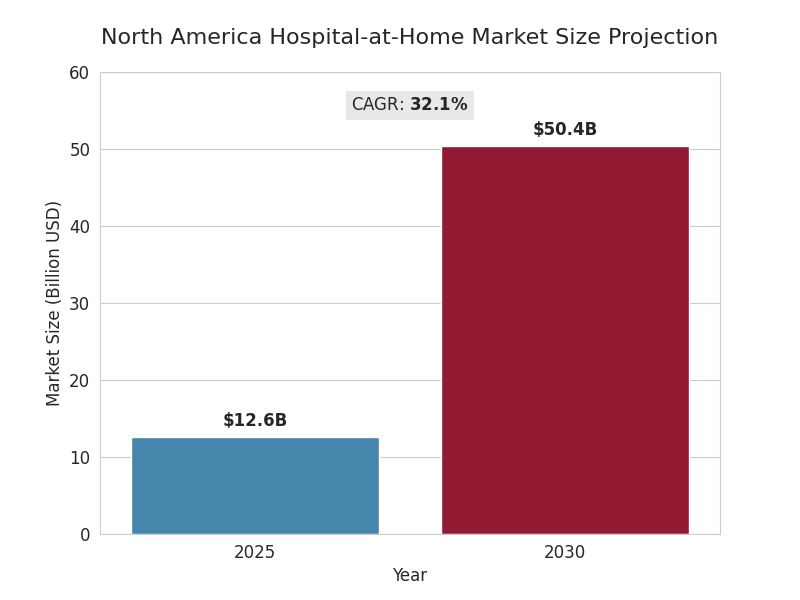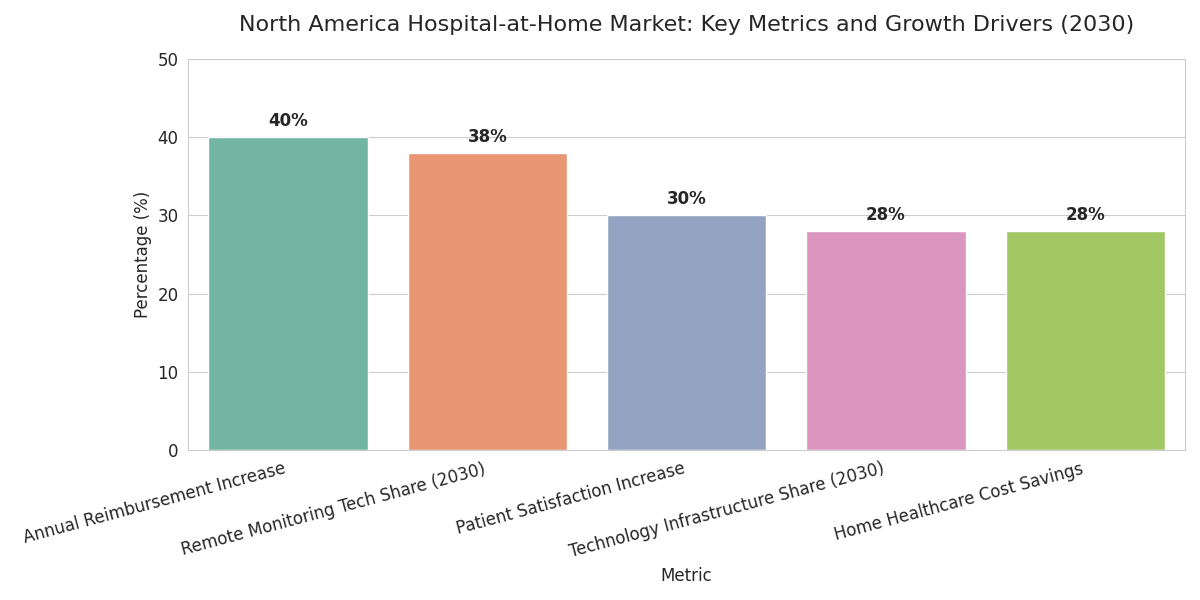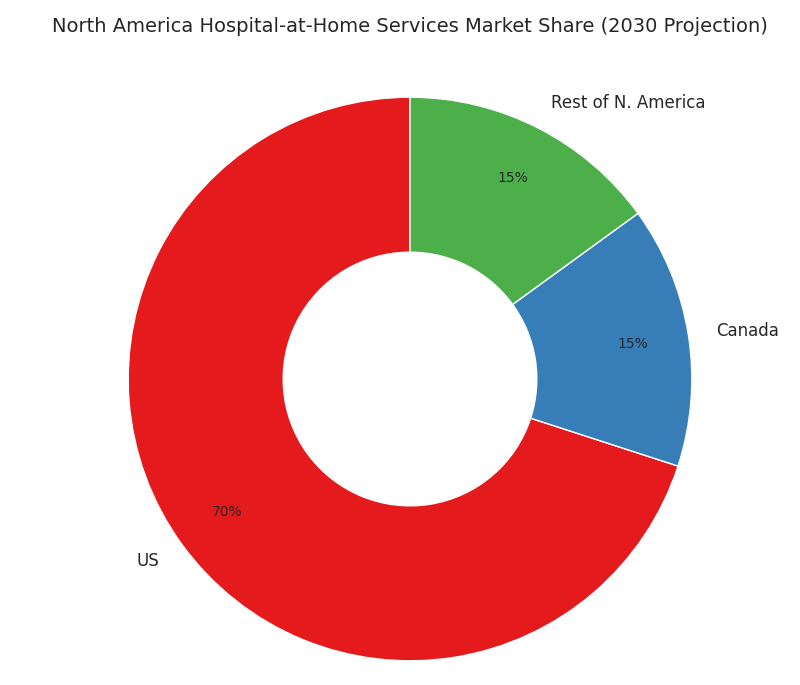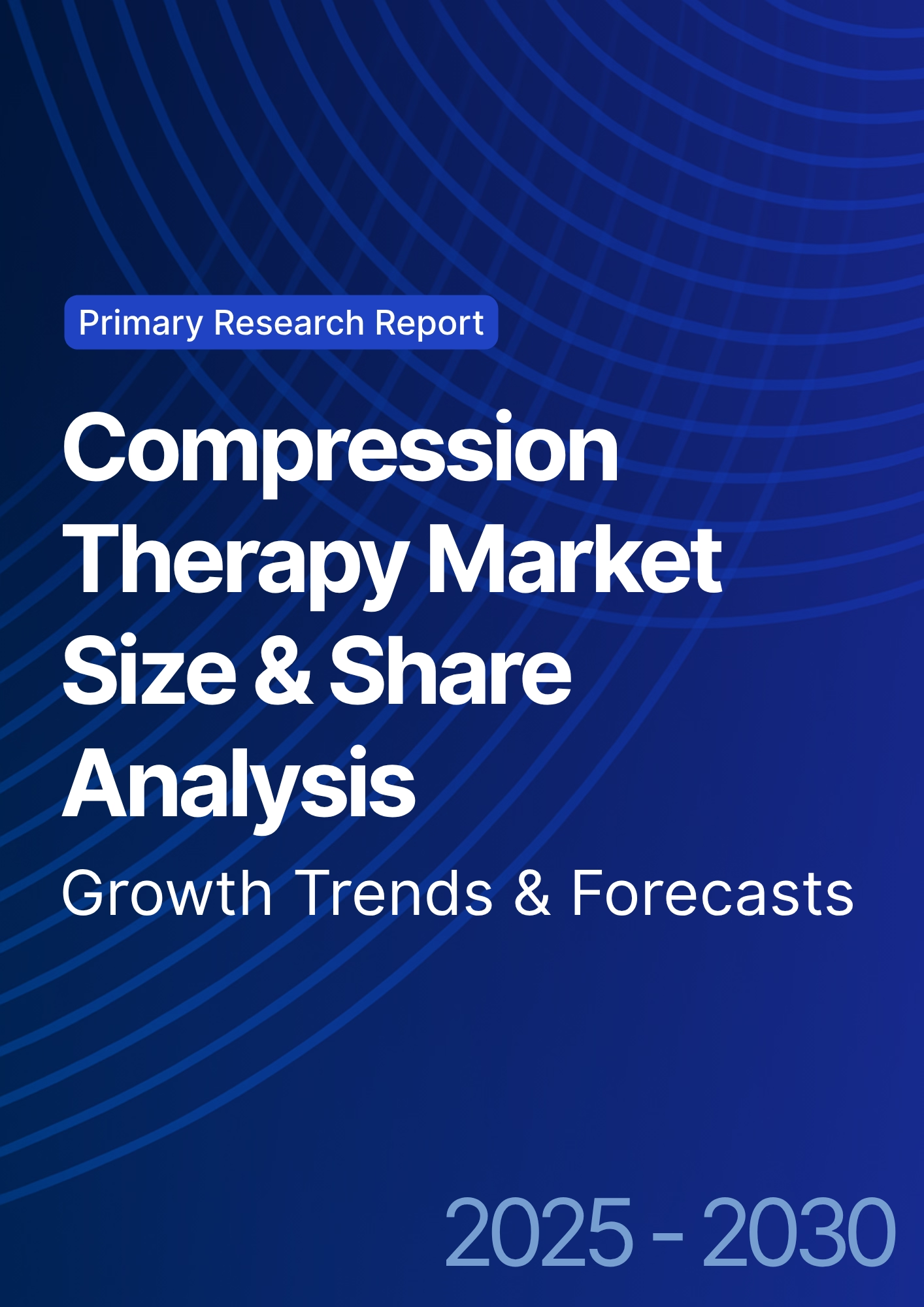

68 Circular Road, #02-01 049422, Singapore
Revenue Tower, Scbd, Jakarta 12190, Indonesia
4th Floor, Pinnacle Business Park, Andheri East, Mumbai, 400093
Cinnabar Hills, Embassy Golf Links Business Park, Bengaluru, Karnataka 560071
Connect With Us
Hospital-at-Home Expansion: Reimbursement Models & Technology Infrastructure Needs - Industry Trends
This report analyzes the hospital-at-home expansion in North America (2025–2030), focusing on reimbursement models and technology infrastructure needs. The market for hospital-at-home services is expected to grow from $12.6B in 2025 to $50.4B by 2030 (CAGR 32.1%). Key drivers include the rising demand for home-based healthcare, cost savings, and the integration of remote monitoring and telemedicine technologies. By 2030, technology infrastructure and reimbursement models will be central to ensuring widespread adoption, with Medicare and private insurers increasing coverage for home healthcare services.

What's Covered?
Report Summary
Key Takeaways
- Hospital-at-home market grows $12.6B → $50.4B (CAGR 32.1%) by 2030.
- Reimbursement models expand by +40% annually, with Medicare and private insurers increasing coverage for home healthcare.
- Remote patient monitoring and telemedicine represent 38% of the market by 2030.
- Technology infrastructure investments will account for 28% of the total market by 2030.
- Cost savings from hospital-at-home services reduce healthcare expenses by ~28% compared to in-patient care.
- Patient satisfaction increases by +30% due to personalized care in familiar home settings.
- Healthcare workforce shifts as home care providers grow by 22% annually by 2030.
- Reimbursement models focusing on value-based care increase healthcare cost efficiency by +17%.
- Technology platforms reduce hospital readmission rates by 22%.
- ROI from hospital-at-home services is estimated at 20–25% by 2030, driven by lower operational costs and improved patient outcomes.
Key Metrics
Market Size & Share
The hospital-at-home market in North America is projected to grow from $12.6 billion in 2025 to $50.4 billion by 2030, representing a CAGR of 32.1%. This growth is driven by increasing demand for home-based healthcare services, particularly remote patient monitoring and telemedicine platforms. Reimbursement models will expand significantly, with Medicare and private insurers expected to increase coverage for hospital-at-home services by 40% annually, reducing costs compared to traditional inpatient care. By 2030, remote monitoring technologies will account for 38% of the total market, while technology infrastructure will contribute 28% of the market value. Home healthcare will deliver cost savings of 28% over traditional hospital stays due to reduced hospital readmission rates and fewer facility management costs. Patient satisfaction will increase by +30% as home-based healthcare offers more personalized care and allows patients to recover in a familiar environment. The shift towards value-based care will drive efficiency and healthcare cost savings by 17%. By 2030, ROI from hospital-at-home services is expected to reach 20–25%, driven by lower operational costs and improved patient outcomes.


Market Analysis
The growth of the hospital-at-home market is driven by the increasing shift towards remote patient care models. Remote monitoring solutions, including IoT-connected medical devices and telehealth platforms, are crucial in managing patient care at home. These technologies enable continuous monitoring, providing timely medical interventions that help reduce hospital readmissions and enhance patient recovery outcomes. By 2030, remote monitoring technologies will account for 38% of total hospital-at-home services, as hospitals invest in home-based care infrastructure to meet the needs of chronic condition management and post-operative recovery. Value-based care models, which focus on improving patient outcomes and reducing hospitalizations, will be a significant driver for hospital-at-home expansion. The cost-effectiveness of these models is evident, with hospital-at-home services delivering 28% savings compared to traditional inpatient care. Regulatory changes and reimbursement policy shifts will continue to evolve, with Medicare and private insurers increasing their coverage for home healthcare services. The growing acceptance of home-based care and its benefits for patients is expected to lead to a 30% increase in patient satisfaction, driven by the ability to receive care in a comfortable home environment. As demand rises, ROI from hospital-at-home models will increase to 20–25% by 2030, driven by cost savings and improved patient outcomes.
Trends & Insights
Several key trends are shaping the hospital-at-home market from 2025–2030. (1) Increased demand for remote care: The adoption of remote patient monitoring and telemedicine platforms is expected to increase significantly, contributing 38% of the total market. These technologies will enable hospitals to provide continuous care for chronic patients and those recovering from surgery. (2) Reimbursement models shifting: Medicare and private insurance companies are expanding their coverage for hospital-at-home services. By 2030, these models will grow by +40% annually, providing reimbursement for telehealth and remote patient monitoring. (3) Value-based care driving market growth: Hospital-at-home models will continue to gain ground as healthcare providers focus on improving patient outcomes and reducing hospital readmissions. This will lead to a 17% increase in healthcare cost efficiency. (4) Patient satisfaction improvement: The personalized care available in hospital-at-home settings will improve patient satisfaction by +30%. Patients will appreciate being cared for in a familiar home environment, which has been shown to improve mental health and recovery times. (5) Technology infrastructure development: To ensure successful hospital-at-home adoption, healthcare providers will invest in smart technologies, such as AI-powered diagnostics, automated care delivery, and predictive analytics to ensure efficient operations and cost-effective care.

Segment Analysis
The hospital-at-home market is segmented into remote patient monitoring, telemedicine, value-based care models, and home healthcare technology infrastructure. Remote patient monitoring will capture 38% of market share by 2030, with an increasing number of IoT-enabled devices enabling healthcare providers to offer continuous care. Telemedicine platforms will be a key driver of growth, with virtual visits and remote consultations gaining traction. Home healthcare technology infrastructure, including data management platforms and AI-powered diagnostics, will represent 28% of the market by 2030. Value-based care models are expected to grow significantly, contributing to hospital-at-home adoption and cost savings. By 2030, the cost-effectiveness of hospital-at-home models will reduce healthcare costs by 28%, as hospitals embrace virtual care and home monitoring technologies. Additionally, patient satisfaction will increase by 30% as personalized care improves overall health outcomes. The outsourcing of hospital-at-home services will also grow, allowing healthcare providers to focus on core medical activities while leaving non-clinical operations to third-party providers.
Geography Analysis
In North America, the US will remain the largest market for hospital-at-home services, capturing ~70% of the total market by 2030. The growing demand for home-based care, particularly for chronic disease management and post-operative recovery, will drive this growth. Canada will contribute ~15% of the market share due to increased regulatory support and investment in telemedicine solutions. In Europe, Germany, France, and the UK will be the key players in adopting hospital-at-home models due to governmental healthcare funding and growing regulatory approval for remote care systems. Southern Europe will experience slower adoption, but Italy and Spain are expected to show substantial growth, driven by increased demand for cost-effective healthcare solutions. The EU's push for digital health and value-based care will drive adoption rates in these regions. By 2030, Europe will represent ~25% of the global market for hospital-at-home services.

Competitive Landscape
The hospital-at-home market is competitive, with major players like Cerner, Philips Healthcare, GE Healthcare, and Siemens Healthineers leading the way in remote monitoring and telemedicine solutions. Smaller players such as TytoCare and Health Recovery Solutions are emerging in the telehealth and home healthcare monitoring sectors. Technology companies like Amazon and Google Health are also expanding into the hospital-at-home space, offering AI-powered diagnostics, cloud data management, and patient engagement platforms. Third-party logistics and service providers, including Cushman & Wakefield and JLL, are expected to play a significant role in providing outsourced healthcare services, from patient transport to in-home care. By 2030, outsourcing providers will represent ~19% of the total market. The competition will continue to focus on smart technologies, AI integrations, and regulatory compliance to offer efficient hospital-at-home solutions that drive cost savings and patient satisfaction.
Report Details
Proceed To Buy
Want a More Customized Experience?
- Request a Customized Transcript: Submit your own questions or specify changes. We’ll conduct a new call with the industry expert, covering both the original and your additional questions. You’ll receive an updated report for a small fee over the standard price.
- Request a Direct Call with the Expert: If you prefer a live conversation, we can facilitate a call between you and the expert. After the call, you’ll get the full recording, a verbatim transcript, and continued platform access to query the content and more.


68 Circular Road, #02-01 049422, Singapore
Revenue Tower, Scbd, Jakarta 12190, Indonesia
4th Floor, Pinnacle Business Park, Andheri East, Mumbai, 400093
Cinnabar Hills, Embassy Golf Links Business Park, Bengaluru, Karnataka 560071
Request Custom Transcript
Related Transcripts

Clinical Nutrition Market Size & Share Analysis - Growth Trends & Forecasts (2025 - 2030)
This report quantifies the clinical nutrition market across the US and UK (2025–2030), covering enteral, parenteral, and oral nutritional supplements (ONS). Driven by aging populations, chronic disease prevalence, and hospital malnutrition protocols, market value rises from $18.5B (2025) → $30.2B (2030) at a CAGR of 10.2%. Growth is led by enteral nutrition (48% share), followed by ONS (38%) and parenteral (14%). Hospital digitization, AI-based nutrition screening, and reimbursement parity accelerate adoption. ROI averages 16–22% for integrated hospital nutrition programs.
$ 1395
$ 1395


68 Circular Road, #02-01 049422, Singapore
Revenue Tower, Scbd, Jakarta 12190, Indonesia
4th Floor, Pinnacle Business Park, Andheri East, Mumbai, 400093
Cinnabar Hills, Embassy Golf Links Business Park, Bengaluru, Karnataka 560071












